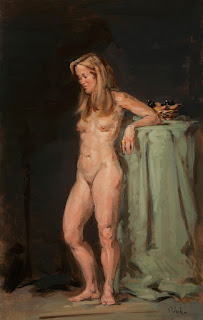In Greek
mythology the muses were inspirational goddesses. In modern usage a muse is a literal person that serves as someone's
source of artistic inspiration. There have been some famous muses who posed for
many different artists. Jo Hiffernan was a muse for Courbet, Whistler, and
Rosetti. Audrey Munson was the inspiration for works by Daniel Chester French, Alexander Calder, and the Piccirilli brothers. Helga Testorf, on the other hand, posed solely for Andrew Wyeth for 15
years.
I met the muse in this painting when I was teaching at the Art Students League of New York. She would pose for my class from time to time over the years. I always enjoyed painting her while giving critiques and working on my student’s paintings. We became friends yet I had never done my own painting of her. When the covid pandemic began the school was closed and in person classes were moved to online classes. During the online classes I worked in my studio as the students worked from their homes. One week Leslie was assigned to my online class. I was thrilled to finally paint my friend and longtime muse. Her natural beauty and amiable disposition made her a marvelous source of inspiration. There was much more to her, however, than the eye could see. I knew her to be warm and sensitive, intelligent and quick witted, strong yet vulnerable. Instead of jumping in and throwing a lot of paint around, I decided to take a slow, deliberate approach. I wanted to focus on drawing out her character rather than filling in the canvas. All my attention was on my muse. I used a palette that was warm and sensitive, allowed my brushwork to be intelligent and quick witted, and applied the paint in a manner that was strong yet vulnerable…

























